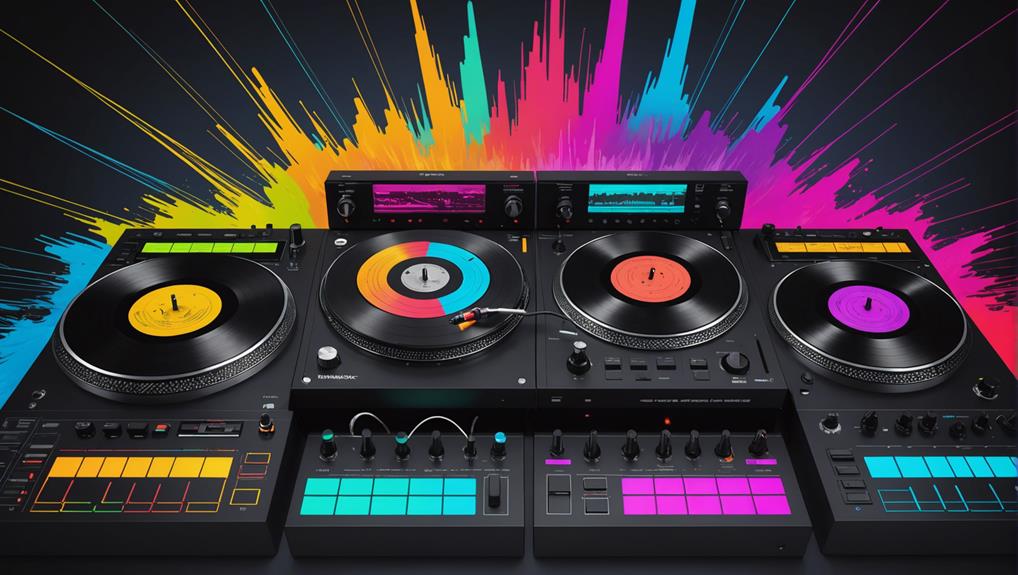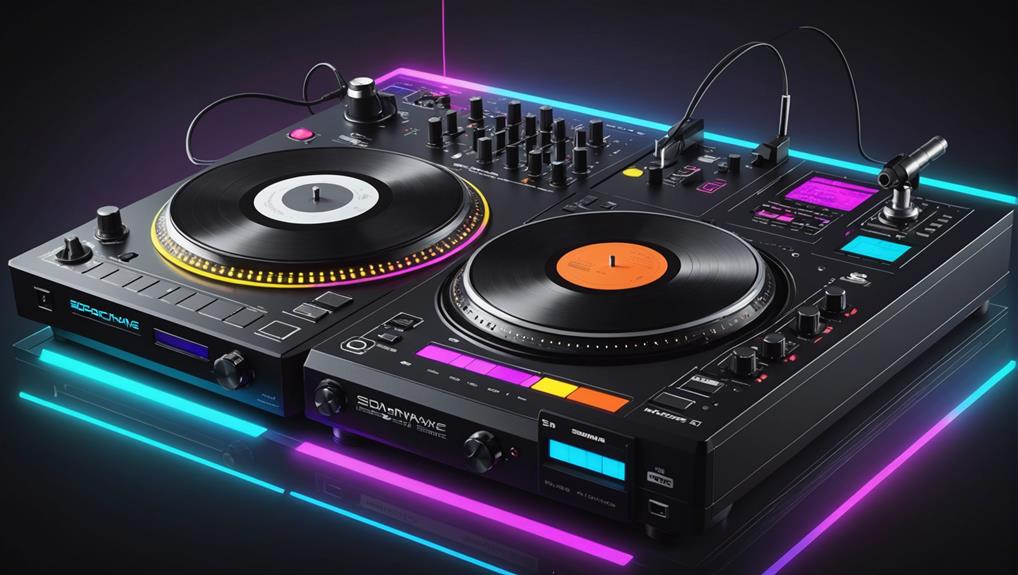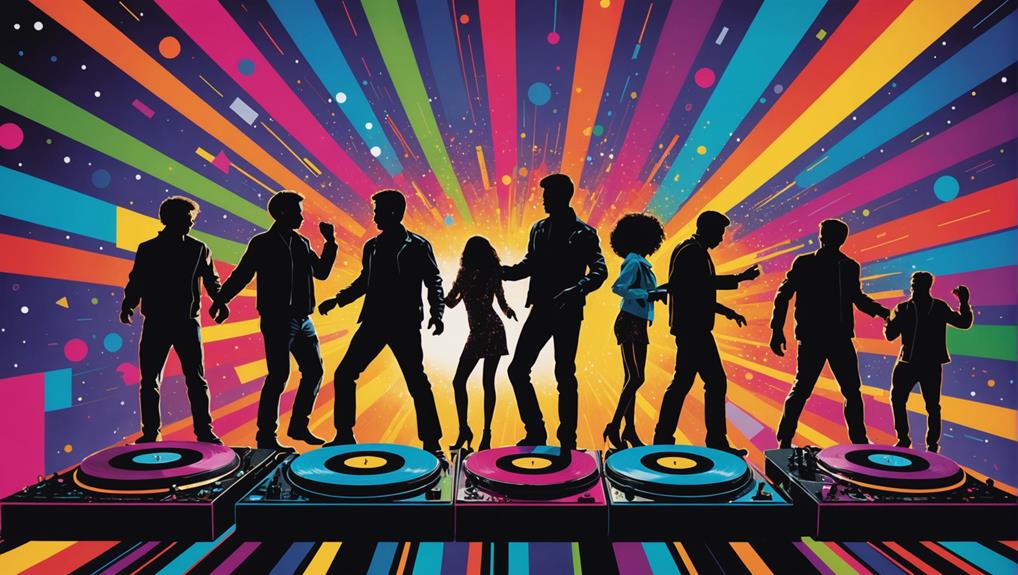No products in the cart.
To trace EDM’s evolution, start by exploring the 1960s revolution, where artists like Robert Moog pioneered synthesizer-based music, setting the stage for diverse sonic landscapes. Then, bridge to the disco and synthpop eras of the 1970s, examining tracks like Donna Summer’s ‘I Feel Love,’ which seamlessly married electronic instruments with classic disco vibes. Explore the 1980s as Detroit and Chicago birthed techno and house, featuring repetitive beats and soul-infused vocals that resonated globally. The 1990s rave culture then propelled EDM from underground clubs to mainstream charts, forging a path for EDM to flourish in festivals and modern digital platforms. Each step reveals deeper layers of EDM’s dynamic journey.
Key Takeaways
- Explore the origins of EDM in the 1960s with pioneers like Robert Moog who revolutionized music with synthesizers.
- Examine the transition from disco to synthpop in the late 70s, highlighting tracks like Donna Summer’s ‘I Feel Love’.
- Study the emergence of techno and house music in 1980s Detroit and Chicago, focusing on the Belleville Three’s innovative techniques.
- Analyze the 90s rave culture and its impact on expanding EDM globally through iconic anthems and underground scenes.
- Observe EDM’s mainstream adoption in the 2000s, including the influence of albums like Madonna’s ‘Ray of Light’ and the rise of major festivals.
Origins of Electronic Dance Music
Electronic Dance Music (EDM), revolutionized by the advent of synthesizers in the 1960s, traces its beginnings to pioneering figures like Robert Moog who transformed musical landscapes with innovative technologies.
You’re delving into a period where the groundwork for today’s pulsating dance tracks was laid by the hands of these electronic music pioneers. Their development of innovative synthesis techniques marked a pivotal turn in how music could be produced and experienced.
The synthesisers introduced by Moog and others allowed for the manipulation of sounds in ways previously unattainable, fostering a new era of musical experimentation. You’d find that these instruments could generate a vast array of sounds— from eerily futuristic bleeps and sweeps to lush, harmonic pads. This capability enabled musicians to craft unique sonic textures that became the hallmark of early electronic music.
As you explore this era, you’ll see how these pioneers used their tools not just for sound replication but for sound creation, pushing the boundaries of what was musically possible. They weren’t just making music; they were designing the auditory landscape of a new musical frontier. This adventurous spirit is essential to understanding the roots of EDM and the genesis of a genre that thrives on innovation.
Rise of Disco and Synthpop
As the 1970s unfolded, disco music, characterized by its use of drum machines and electronic instruments, set the stage for the burgeoning synthpop movement. You can see the clear disco influences in the rhythm and beats that dominated dance floors. This era, pivotal in the development of electronic dance music, laid a robust foundation for the evolution of synthpop.
The shift from disco to synthpop wasn’t abrupt but rather a seamless flow, propelled by technological advancements and changing cultural tides. The introduction of synthesizers and more sophisticated electronic equipment played a vital role in shaping the soundscapes that would define a generation. Here’s how this transformation occurred:
- Donna Summer’s ‘I Feel Love’ showcased a repetitive, synthesized backing track that became emblematic of early synthpop.
- George McCrae’s ‘Rock Your Baby’ illustrated how drum machines could create a compelling, danceable groove that carried disco into the synthpop era.
- Synthpop origins can be traced back to these disco roots, where experimentation with electronic sounds fostered a new genre.
This period in the late 1970s and early 1980s marked a significant chapter in the history of EDM, highlighting a time of significant growth and innovation.
Techno and House Breakthroughs
Building on the electronic foundations laid by disco and synthpop, Detroit and Chicago became the birthplaces of techno and house music respectively in the 1980s. In Detroit, the Belleville Three—Juan Atkins, Derrick May, and Kevin Saunderson—ushered in a new era with their innovative production techniques. They harnessed the rhythmic possibilities of drum machines and synthesizers, crafting a sound that was both futuristic and deeply rooted in urban American life.
Similarly, in Chicago, influential pioneers like Frankie Knuckles and Ron Hardy were pivotal in the development of house music. They transformed the dance music landscape by experimenting with repetitive beats and basslines that created a hypnotic, throbbing pulse. This was complemented by the use of gospel-infused vocals and samples, which added a soulful dimension to the electronic rigor.
These groundbreaking movements didn’t merely exist in isolation. Their sonic innovations laid the groundwork for a plethora of subgenres and influenced countless artists globally. The hypnotic grooves and textured rhythms of techno and house captivated audiences, setting the stage for the expansive growth of electronic dance music. Through their pioneering efforts, Atkins, May, Saunderson, Knuckles, and Hardy not only revolutionized music production but also paved the way for the global EDM movement.
90s Rave Culture Expansion
As you explore the expansion of rave culture, you’ll observe how underground scenes emerged as sanctuaries for the burgeoning electronic music community.
Iconic rave anthems, characterized by their pulsating rhythms and melodic basslines, played a pivotal role in transcending local boundaries and fostering a global influence.
This period not only spread EDM across continents but also reshaped the cultural landscapes of numerous societies, integrating electronic music into mainstream consciousness.
Underground Scenes Emerge
During the late 1980s and early 1990s, rave culture began to take shape as underground scenes hosted massive outdoor parties and warehouse raves. These underground movements had a profound impact on cultural norms and societal structures. You can observe how electronic music not only drove societal change but also created a new form of communal experience and identity among youths.
- Experimentation and Innovation: DJs and producers experimented with new electronic sounds, pushing the boundaries of music production.
- Community and Solidarity: Raves became safe havens for self-expression and escape, fostering a sense of unity among attendees.
- Political and Social Repercussions: The rave scene’s growth led to increased scrutiny and legislation, highlighting its disruptive impact on conventional societal norms.
Iconic Rave Anthems
Iconic rave anthems such as ‘Insomnia’ by Faithless and ‘Born Slippy’ by Underworld not only encapsulated the spirit of the 1990s rave culture expansion but also revolutionized the electronic dance music scene with their pioneering sounds.
These tracks, with their pulsating rhythms and hypnotic melodies, exemplified the evolutionary influences of earlier electronic styles, weaving them into complex, layered compositions that resonated with a burgeoning youth movement.
The cultural significance of anthems like ‘Higher State of Consciousness‘ by Josh Wink and ‘Pacific State’ by 808 State is profound; they fostered a sense of unity and collective euphoria, pivotal in shaping the communal ethos of rave culture.
Their enduring popularity underscores their foundational role in the continuous evolution of EDM.
Global Influence Spreads
Building on the foundational sounds pioneered by iconic rave anthems, the 1990s witnessed EDM’s rapid proliferation across continents, transforming it from a niche underground phenomenon to a global cultural force. This era marked the beginning of cultural globalization and festival diplomacy, where EDM became a tool for international connection and cultural exchange.
- Love Parade in Berlin: Symbolized the unifying power of EDM, attracting enthusiasts from across the globe.
- Cross-genre collaborations: DJs and producers blended EDM with local music forms, creating fusion influences that resonated worldwide.
- Controversial discussions in the U.S.: Sparked by Senator Joe Biden’s rave ban, these debates highlighted the cultural impact and global reach of EDM, underscoring its significance in youth culture.
Mainstream Adoption in the 2000s
Madonna’s 1998 album ‘Ray of Light’ greatly influenced the early 2000s mainstream acceptance of electronic dance music (EDM). Featuring a blend of techno, ambient, and electronica, the album not only garnered critical acclaim but also achieved significant commercial success, illustrating the genre’s potential for mainstream appeal. This period marked a shift as EDM began to move from niche underground clubs to dominate global music charts.
The rise of international DJs and producers like Tiësto, Daft Punk, and David Guetta further cemented EDM’s commercial viability. These artists brought distinct sounds and production techniques to the forefront, enabling EDM to resonate with a broader audience. Their involvement in high-profile collaborations and remixes of popular songs from various genres attracted listeners who mightn’t have otherwise engaged with EDM.
Simultaneously, the introduction of dubstep in the U.S. through figures like Skrillex introduced a new, grittier dimension to EDM, appealing particularly to younger audiences. The 2000s also saw an explosion in EDM-driven festivals and events, which became cultural phenomena. These gatherings not only showcased the genre’s diverse sub-genres but also unified a vast community of EDM enthusiasts, further propelling the music into a staple of contemporary popular culture.
Innovation and Technology Impact
Technological advancements have fundamentally transformed the landscape of electronic dance music, enabling artists to explore and create new sonic dimensions. The introduction of MIDI and digital audio workstations has revolutionized your understanding of music production. These tools haven’t only streamlined the creative process but also expanded the domain of possibilities within the genre, fostering a culture of innovation that continuously feeds back into itself.
Here’s how these changes have specifically impacted EDM:
- Synthesizers and drum machines: These have allowed for the creation of richer, more complex soundscapes that are distinctly electronic.
- Digital audio workstations: They serve as the backbone of music production, enabling intricate editing and manipulation of sounds that were once impossible.
- Virtual reality experiences: These are redefining performance spaces, offering you immersive environments that enhance the sensory impact of the music.
This cycle of techno innovation hasn’t only influenced the sounds you hear but also the very nature of how EDM is experienced. Virtual reality experiences, for instance, are transforming traditional performance paradigms into interactive, multimedia events. Such advancements make certain that the evolution of EDM is as dynamic as the music itself, continually pushing the boundaries of what’s possible in electronic music.
The Future and Evolution of EDM
As you explore the evolving landscape of EDM, you’ll notice that the integration of virtual reality in live performances is setting new standards for immersive experiences. Virtual reality experiences aren’t only enhancing the sensory engagement of audiences but are also redefining the spatial dynamics of EDM events. This technological infusion allows you to experience performances in a multi-dimensional space, transcending traditional auditory and visual boundaries.
Moreover, the push for sustainability initiatives within EDM festivals is becoming increasingly prominent. Organizers are now prioritizing eco-friendly practices, from waste reduction to energy efficiency, ensuring that the environmental footprint of each event is minimized. This shift not only reflects a broader cultural commitment to sustainability but also influences the operational and creative aspects of festival management.
Additionally, the genre is experiencing a significant transformation through genre fusion and mainstream collaborations. These partnerships are diluting the once rigid lines between EDM and other music genres, fostering a rich, eclectic musical landscape. As EDM artists collaborate with mainstream musicians, they’re crafting a versatile and appealing global sound, accessible to a wider audience than ever before. This evolution is pivotal in shaping EDM’s future trajectory, making it a continually adaptive and vibrant musical genre.
Frequently Asked Questions
How Has EDM Changed Over Time?
EDM’s transformation over time reflects technology’s impact and genre fusion. You’ve witnessed its growth from niche to mainstream, driven by evolving production techniques and the blending of diverse musical styles.
How Has Electronic Music Evolved?
Electronic music’s evolution reflects significant genre fusion and technology impact. You’ve witnessed its growth from simple synthesizers to complex digital platforms, blending diverse influences into the rich tapestry of today’s EDM scene.
Is Daft Punk an EDM?
Yes, Daft Punk is an EDM group. Their innovative live performances and diverse influences, including disco and funk, greatly shaped EDM’s development, illustrating a deep, transformative impact on the genre’s global scene.
Who Pioneered Edm?
You’re exploring who pioneered EDM. Early synthesizers played a vital role, especially in techno origins, where the Belleville Three and Kraftwerk were instrumental. Their innovations shaped the foundational sounds and techniques of EDM.
Conclusion
You’ve journeyed through EDM’s rich history, from its underground origins to its global prominence. Analyzing each phase, you’ve seen how technological innovations and cultural shifts have shaped its evolution.
As you look forward, consider the continuous interplay between technology and artistry that drives EDM’s development. Your understanding of this dynamic genre’s past will indubitably enrich your appreciation of its future innovations, ensuring a deeper engagement with the ever-evolving landscape of electronic dance music.




